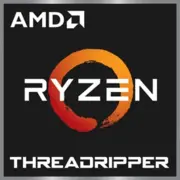AMD Ryzen Threadripper PRO 7945WX

AMD Ryzen Threadripper PRO 7945WX: Power for Professionals
Examining a processor that redefines the concept of a "workstation."
Key Features: Architecture and Performance
Storm Peak Architecture and 5nm Process Technology
The Ryzen Threadripper PRO 7945WX processor is built on the Zen 4 architecture (codename Storm Peak) and manufactured using TSMC's 5nm FinFET process. This ensures high transistor density and energy efficiency, despite a TDP of 350 watts.
- 12 Cores / 24 Threads: Optimal balance for tasks requiring multi-threading without excessive heating.
- 64 MB L3 Cache: Accelerates data processing in applications with large computational workloads (rendering, simulations).
- PCIe 5.0 Support: 128 PCIe 5.0 lanes allow for connecting multiple graphics cards, NVMe drives, and peripherals without speed loss.
Performance in Numbers
In Geekbench 6 tests:
- Single-Core: 2756 — comparable to top gaming CPUs, which is important for low-latency tasks.
- Multi-Core: 19006 — surpasses many HEDT processors (for example, Intel Core i9-13900K scores around ~16,000 in multi-threading).
Key Features:
- Pro Features: ECC memory, overheating protection, remote management via AMD PRO Technologies.
- Extended AVX-512 Instructions: Accelerate machine learning tasks and scientific computations.
Compatible Motherboards: Sockets and Chipsets
Socket sTR5 and Chipsets WRX90/TRX90
The Threadripper PRO 7945WX uses the sTR5 socket, requiring specialized motherboards:
- Chipset WRX90: For professional workstations (ASUS Pro WS WRX90-SAGE SE, ASRock WRX90).
- Chipset TRX90: More affordable options with overclocking support (Gigabyte TRX90 AORUS Master).
Choosing Features:
- 8 DDR5 Slots: Quad-channel configuration is mandatory for maximum bandwidth.
- VRM Cooling: Due to the 350W TDP, motherboards are equipped with large heatsinks and even fans (for example, ASUS Pro WS).
- Connection Ports: 10 Gb Ethernet, Thunderbolt 4, multiple USB4.
Practical Example: Building on ASUS Pro WS WRX90 allows the connection of four NVIDIA RTX A6000 GPUs for rendering in Blender without bottlenecks.
Supported Memory: DDR5 and ECC
The Threadripper PRO 7945WX works only with DDR5, including ECC modules.
- Frequencies: Up to 5200 MHz (JEDEC), with the possibility of overclocking to 6400 MHz in unbuffered mode.
- Quad-Channel Mode: Bandwidth up to 204.8 GB/s compared to ~50 GB/s for dual-channel DDR4.
Recommendations:
- For workstations — Kingston Server Premier DDR5-4800 ECC.
- For enthusiasts — G.Skill Trident Z5 DDR5-6400 (non-ECC).
Power Supplies: Calculations and Recommendations
With a TDP of 350W and peak load up to 420W (including GPU and peripherals), the requirements are:
- Minimum 850W: For a system with one graphics card (e.g., NVIDIA RTX 4080).
- Optimal 1000–1200W: For multi-processor configurations (2–3 GPUs, RAID arrays).
Selection Criteria:
- 80+ Platinum or Titanium certification (Corsair AX1600i, Seasonic PRIME TX-1000).
- Support for ATX 3.0 standard with 12VHPWR cables for modern GPUs.
Assembly Mistakes: Using a 750W PSU from a no-name Chinese manufacturer leads to overloads and shutdowns during rendering.
Pros and Cons of Threadripper PRO 7945WX
Strengths:
1. Best-in-class multi-threaded performance.
2. Support for ECC memory and PCIe 5.0.
3. Optimization for professional software (AutoCAD, Maya, Unreal Engine).
Weaknesses:
1. Price: Starting at $1500 for the processor + expensive motherboards (from $800).
2. Power consumption: Not suitable for home PCs without robust cooling.
3. Overkill for everyday tasks: Office applications won't even load 10% of the CPU.
Usage Scenarios: Where Potential Unfolds
1. 3D Rendering and Animation: In Redshift or V-Ray, 12 cores reduce rendering time by 30% compared to Ryzen 9 7950X.
2. Virtualization: Running 10+ VMs simultaneously without lag.
3. Engineering Calculations: ANSYS, MATLAB process data 1.5–2 times faster than Intel Xeon W5-2465X.
4. Streaming and Encoding: NVENC + CPU encoding in OBS without FPS loss.
Not Suitable For:
- Gaming: Most games are not optimized for 24 threads, and the max frequency of 5.1 GHz lags behind Ryzen 7 7800X3D (up to 5.6 GHz).
- Budget Builds: System prices start around $3000.
Comparison with Competitors
Intel Xeon W5-2465X
- 10 Cores / 20 Threads, DDR5-4800, TDP 300W.
- Lags in multi-threading (~17,000 in Geekbench 6), but excels in tasks with AVX-512.
AMD Ryzen 9 7950X
- Desktop CPU with 16 cores and TDP of 170W.
- Cheaper, but lacks ECC support and PCIe 5.0 x128.
Final Verdict: The Threadripper PRO 7945WX is the choice for professionals who need the reliability of ECC and scalability.
Practical Assembly Tips
1. Cooling:
- Liquid cooling systems with a TDP capacity of at least 400W (e.g., NZXT Kraken Z73).
- Cases with good airflow (Lian Li Lancool III, Fractal Design Torrent).
2. Turnkey Build:
- CPU: Threadripper PRO 7945WX.
- Motherboard: ASUS Pro WS WRX90-SAGE SE.
- Memory: 128 GB DDR5-5200 ECC.
- PSU: Corsair AX1600i.
3. Testing:
- Stability checks in Prime95 and MemTest86.
- Power profile adjustments in BIOS for a balance between performance and noise.
Final Conclusion: Who is Threadripper PRO 7945WX For?
This processor is designed for:
- Professionals: Architects, engineers, AI developers.
- Studios: Rendering farms, editing stations.
- Enthusiasts: Tech enthusiasts building a "monster" for personal projects.
Why Choose It? No other desktop CPU offers such a level of reliability, scalability, and support for professional technologies. If your income relies on computational speed — this is an investment that will pay off.
Basic
CPU Specifications
Memory Specifications
GPU Specifications
Benchmarks
Compared to Other CPU
Share in social media
Or Link To Us
<a href="https://cputronic.com/en/cpu/amd-ryzen-threadripper-pro-7945wx" target="_blank">AMD Ryzen Threadripper PRO 7945WX</a>